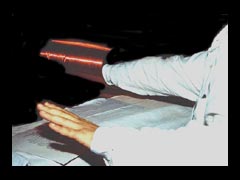 |
|||
| |
|
In which circumstances or on what occasion did you introduce [electricity or electronics] TELEMATICS or THE NETWORK in your work? Ken Goldberg: My first project involving Telematics was "Data Dentata" (1992), a primitive machine that allowed two people to hold hands over the telephone. See: www.ken.goldberg.net Randall Packer: My first art project that involved telematics was "Mori" (1999), although I have been teaching and curating telematic art since 1996. How can you describe the technical and aesthetical part played by [electricity] TELEMATICS in the work you will be showing in the [Electra] TELEMATIC CONNECTIONS exhibition? Please give your comments as regards these points. KG: The network is essential to the "Mori" sound installation as it provides live streaming data from the seismograph. If the data were prerecorded (not telematic) the experience would be completely different conceptually. One question is how a viewer knows the data is live. This is the fundamental problem of telepistemology. RP: From my perspective, as the composer of "Mori," the network serves as an opportunity to open up new possibilities for sculpting and modifying sound. In this case, the network has made it possible to use the movement of the earth in real time as a control source for shaping sound according to the constant fluctuations of terrestrial activity. According to you, which are the consequences that can arise from
the KG: Telematic art should question its own foundations. Tele-experience is rarely a satisfactory substitute for being there. Telematic artworks can illuminate what is lacking in communications. RP: Clearly, telematics has created new possibilities for
the experience of art, particularly in the realm of live media,
as well as the modes of interaction among a collective audience.
In the short lifespan of the network as a medium for art, the emphasis
has been on the personal computer and the ubiquitous browser as
an interface to online art. This will and must change. As telematics
become more integrated into our physical world, so too will the
telematic artwork. In such established genres as installation art,
live performance, electronic theater, and environmental work, interaction
with the network will become, and is already becoming, an integral
part of the artist's creative task, and fundamental to the *These questions are based on ones asked by Frank Popper of the artists in his seminal exhibition Electra: Electricity and Electronics in the Art of the 20th Century in 1983 at the Musée d'Art Moderne de la Ville Paris |
